Search Result
Results for "
ubiquitin-proteasome
" in MedChemExpress (MCE) Product Catalog:
1
Isotope-Labeled Compounds
| Cat. No. |
Product Name |
Target |
Research Areas |
Chemical Structure |
-
- HY-162331
-
|
|
STING
|
Inflammation/Immunology
Cancer
|
|
STING Degrader-1 (compound 2) is a potent STING degrader that covalently binds to STING and E3 ligase. STING Degrader-1 induces STING degradation through a ubiquitin-proteasome system-dependent pathway .
|
-
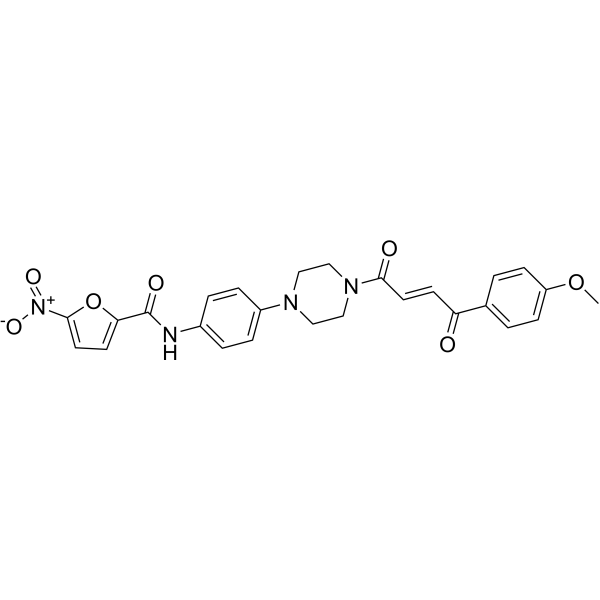
-
- HY-N10332
-
|
|
Proteasome
|
Cancer
|
|
Leptosphaerodione, isolated from Remotididymella sp. Fungus, is a potent ubiquitin-proteasome system (UPS) inhibitor. Leptosphaerodione exhibits cytotoxicity in HeLa cells with IC50 value of 3.2 μM. Anti-tumor agent .
|
-
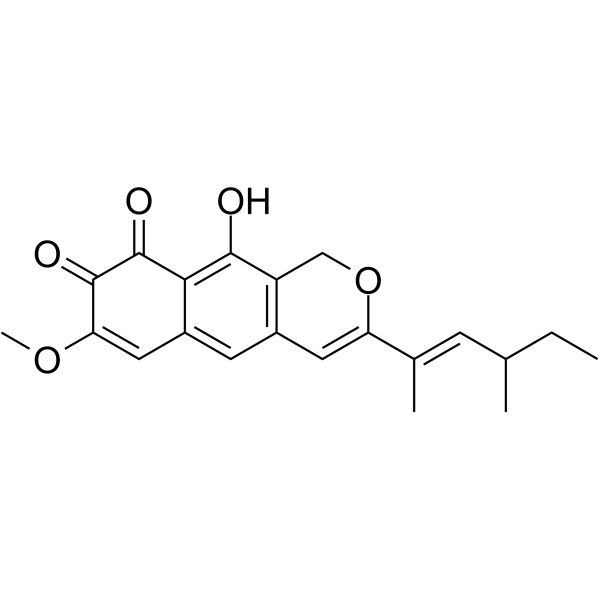
-
- HY-152145
-
|
|
PROTACs
Ras
|
Cancer
|
|
PROTAC SOS1 degrader-3 is a potent PROTAC SOS1 degrader. PROTAC SOS1 degrader-3 effectively targeted SOS1 for degradation through the ubiquitin-proteasome system .
|
-
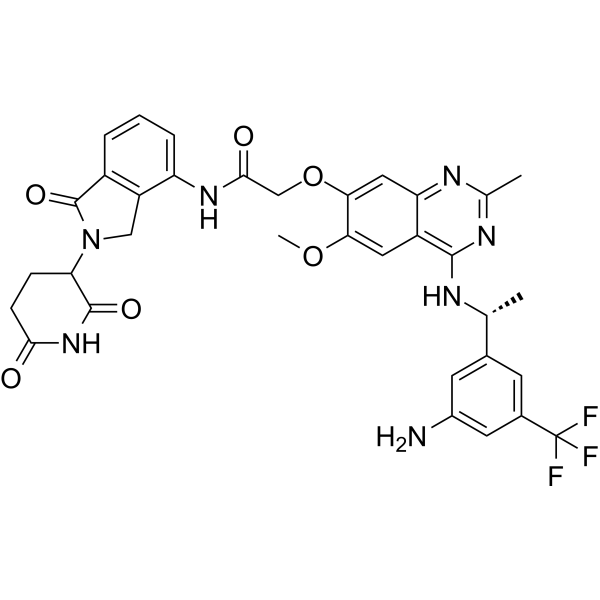
-
- HY-143883
-
|
|
Akt
|
Cancer
|
|
MS143 is a potent AKT degrader (DC50=46 nM and GI50=0.8 µM in PC3 cells). MS143 induces rapid and robust AKT degradation in a concentration- and time-dependent manner via hijacking the ubiquitin-proteasome system. MS143 can suppress cancer cell growth .
|
-

-
- HY-157230
-
|
|
Others
|
Cancer
|
|
XIAP antagonist 1 (compound A4) is a XIAP-specific antagonist, XIAP antagonist 1 degradation of XIAP via the ubiquitin-proteasome pathway .
|
-
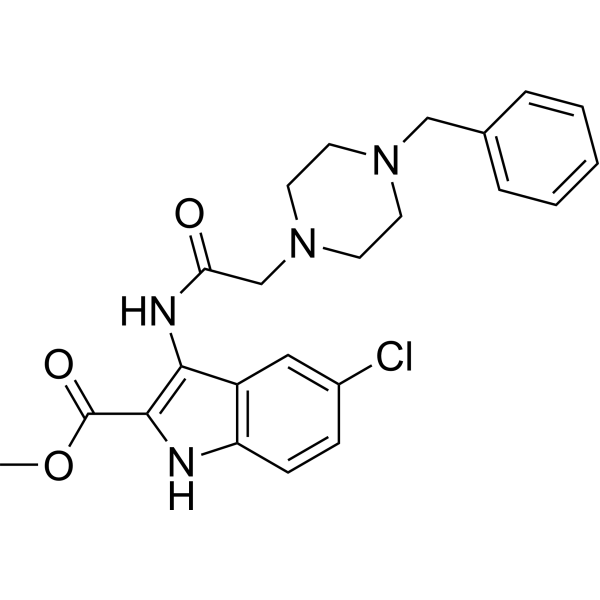
-
- HY-152154
-
|
|
PROTACs
NAMPT
|
Cancer
|
|
Nampt degrader-2 is a fluorescent PROTAC, which efficiently degrades NAMPT with an IC50 of 41.9 nM. Nampt degrader-2 binds to NAMPT and VHL to form a ternary complex and subsequently induced NAMPT degradation via ubiquitin-proteasome system (UPS). Nampt degrader-2 leads to significant reduction of NAD + and exerts potent antitumor activities .
|
-
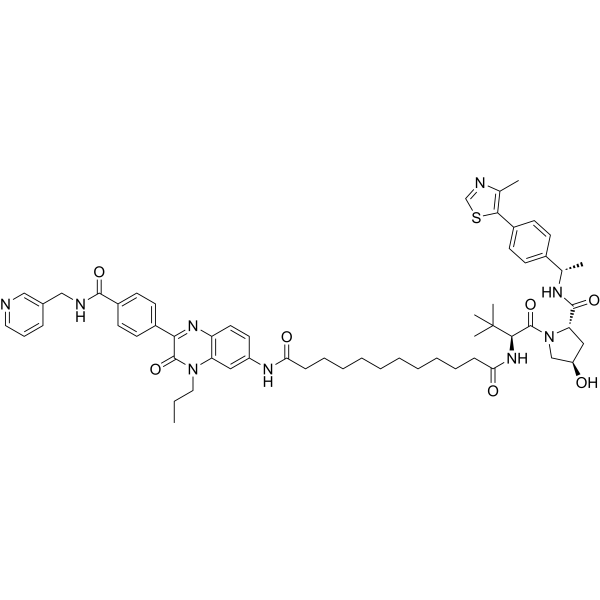
-
- HY-139606
-
|
|
p97
|
Cancer
|
|
VCP/p97 inhibitor-1 is a potent inhibitor of VCP/p97 (also called Cdc48, CDC-. 48, or Ter94) with an IC50 of 54.7 nM. VCP/p97 inhibitor-1 causes the dysregulation of protein homeostasis and disturbs the degradation of misfolded polypeptides by the ubiquitin-proteasome system (UPS) .
|
-
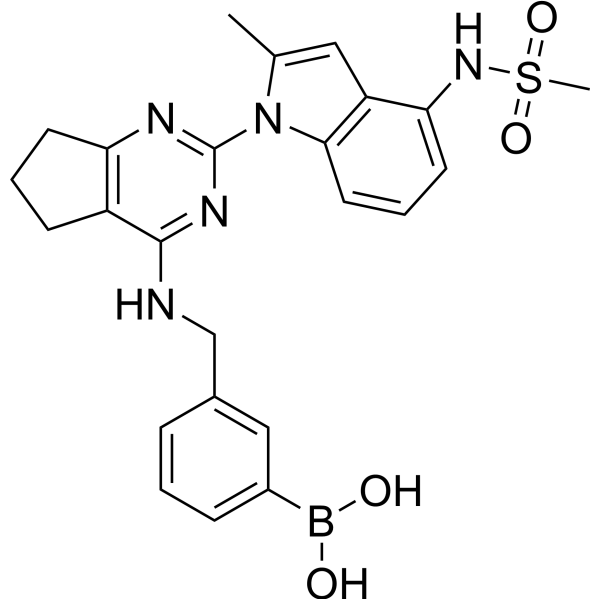
-
- HY-W054146
-
RAMB4
1 Publications Verification
|
Proteasome
|
Cancer
|
|
RAMB4 is a ubiquitin-proteasome system (UPS)-stressor. RAMB4 inhibits ubiquitin-mediated protein degradation upstream of the 20S proteasomal catalytic activites. RAMB4 triggers a ubiquitin-proteasome-system (UPS)-stress response without affecting 20S proteasome catalytic activities. Anticancer activity .
|
-
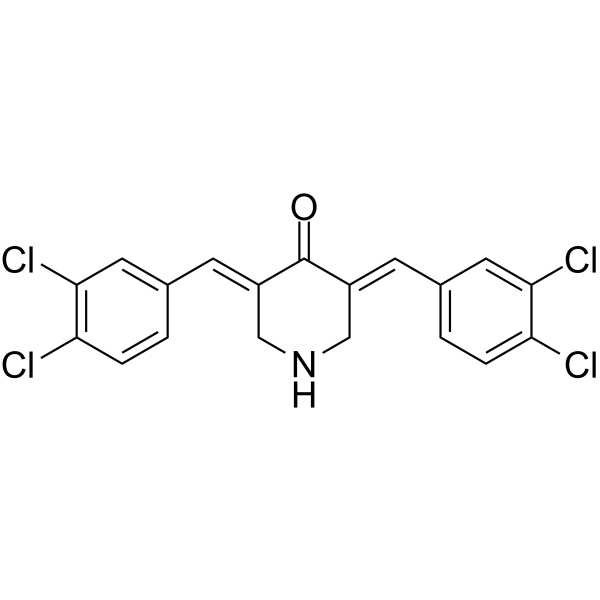
-
- HY-111876A
-
|
|
SNIPERs
|
Cancer
|
|
SNIPERTACC3-1 hydrochloride targets the TACC3 protein for degradation via the ubiquitin-proteasome pathway based on IAP ligand. SNIPERTACC3-1 hydrochloride induces cancer cell death .
|
-
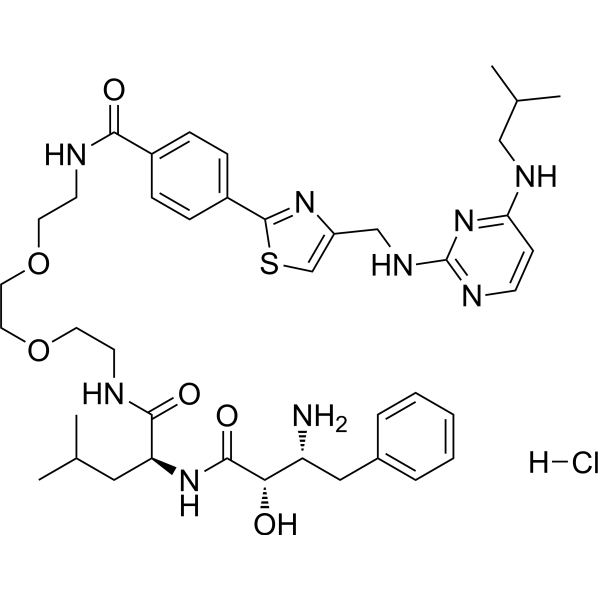
-
- HY-111876
-
|
|
SNIPERs
|
Cancer
|
|
SNIPER(TACC3)-1 targets the TACC3 protein for degradation via the ubiquitin-proteasome pathway based on IAP ligand. SNIPER(TACC3)-1 induces cancer cell death .
|
-
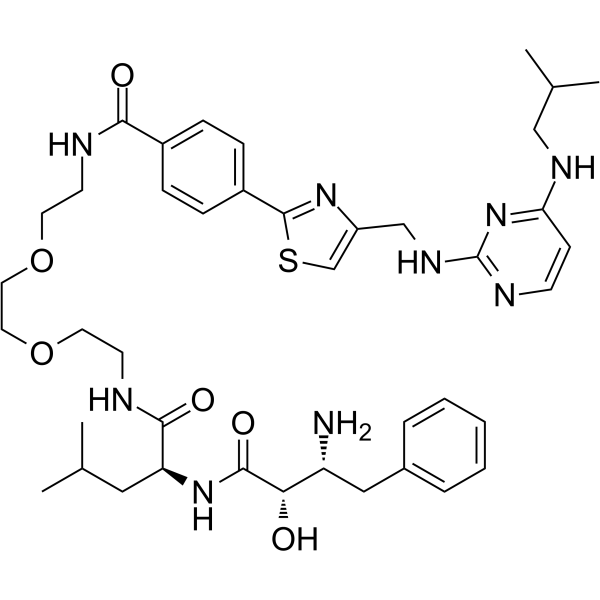
-
- HY-111877
-
|
|
SNIPERs
|
Cancer
|
|
SNIPER(TACC3)-2 targets the TACC3 protein for degradation via the ubiquitin-proteasome pathway based on IAP ligand. SNIPER(TACC3)-2 induces cancer cell death .
|
-
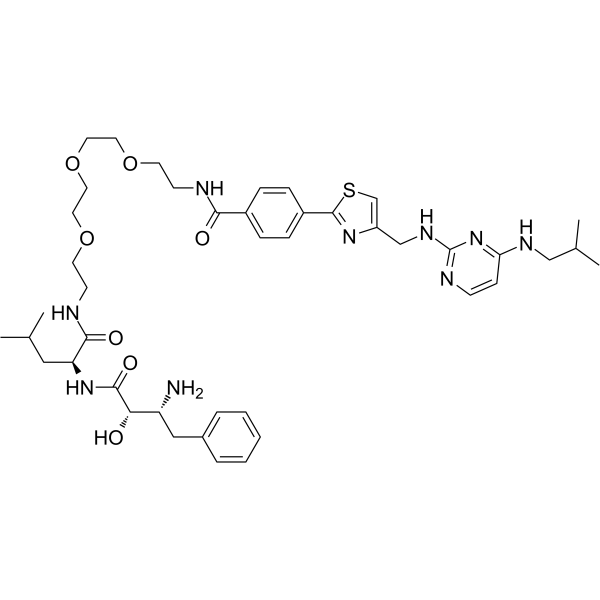
-
- HY-111877A
-
|
|
SNIPERs
|
Cancer
|
|
SNIPER(TACC3)-2 hydrochloride targets the TACC3 protein for degradation via the ubiquitin-proteasome pathway based on IAP ligand. SNIPER(TACC3)-2 hydrochloride induces cancer cell death .
|
-

-
- HY-P1259
-
|
|
Proteasome
Bacterial
|
Inflammation/Immunology
|
|
PR-39, a natural proline- and arginine-rich antibacterial peptide, is a noncompetitive, reversible and allosteric proteasome inhibitor. PR-39 reversibly binds to the α7 subunit of the proteasome and blocks degradation of NF-κB inhibitor IκBα by the ubiquitin-proteasome pathway. PR-39 stimulates angiogenesis, inhibits inflammatory responses and significant reduces myocardial infarct size in mice .
|
-

-
- HY-137487
-
|
|
PROTACs
Raf
|
Cancer
|
|
PROTAC BRAF-V600E degrader-1 is a potent PROTAC BRAF-V600E degrader with Kd value of 2.4 nM and 2 nM for BRAF and BRAF-V600E, respectively. PROTAC BRAF-V600E degrader-1 degrades BRAF-V600E via the ubiquitin-proteasome system (UPS). PROTAC BRAF-V600E degrader-1 can inhibit melanoma cell growth .
|
-
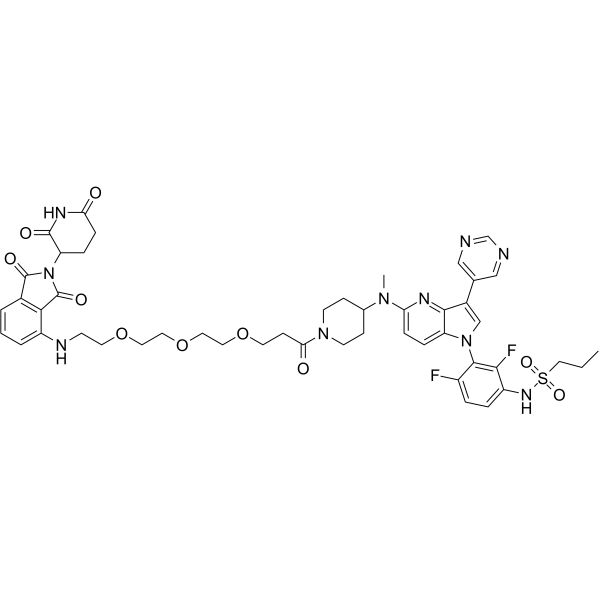
-
- HY-P1259A
-
|
|
Proteasome
Bacterial
|
Inflammation/Immunology
|
|
PR-39 TFA, a natural proline- and arginine-rich antibacterial peptide, is a noncompetitive, reversible and allosteric proteasome inhibitor. PR-39 TFAreversibly binds to the α7 subunit of the proteasome and blocks degradation of NF-κB inhibitor IκBα by the ubiquitin-proteasome pathway. PR-39 TFA stimulates angiogenesis, inhibits inflammatory responses and significant reduces myocardial infarct size in mice .
|
-
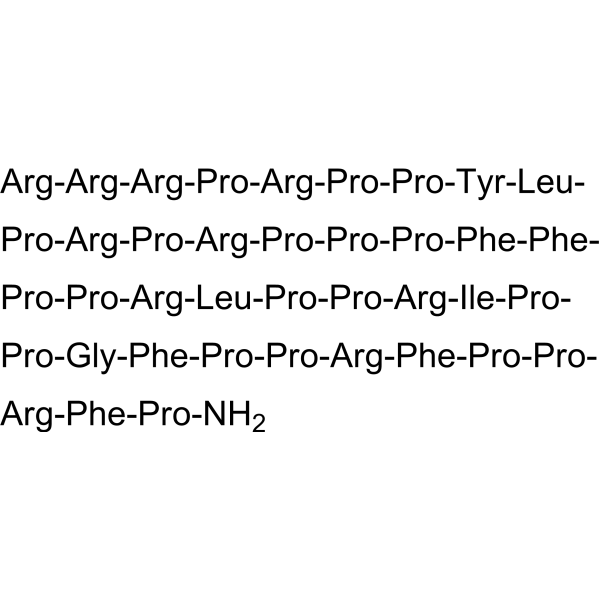
-
- HY-148523
-
|
|
Others
|
Cancer
|
|
HQ005 is a potent CCNK degrader with an DC50 value of 0.041 µM. HQ005 is a molecular-glue degrader that mediates interactions between target proteins and components of the ubiquitin-proteasome system to cause selective protein degradation .
|
-
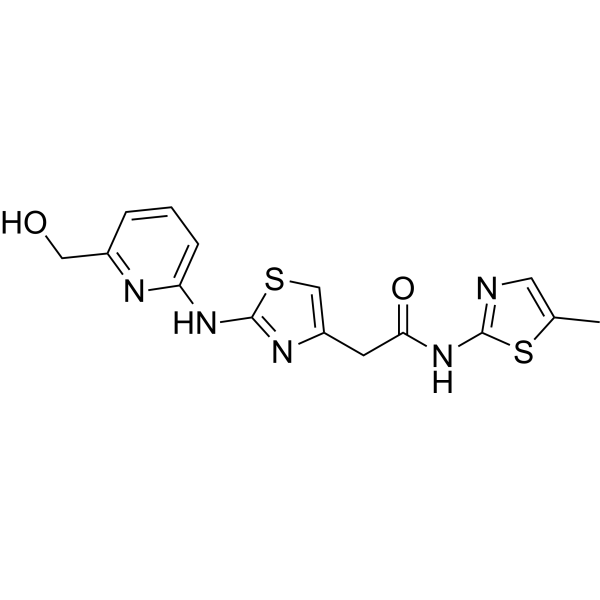
-
- HY-19726
-
|
|
MDM-2/p53
|
Cancer
|
|
NSC59984 induces mutant p53 protein degradation via MDM2 and the ubiquitin-proteasome pathway . NSC59984 acts by targeting GOF-mutant p53 and stimulates p73 to restore the p53 pathway signaling .
|
-
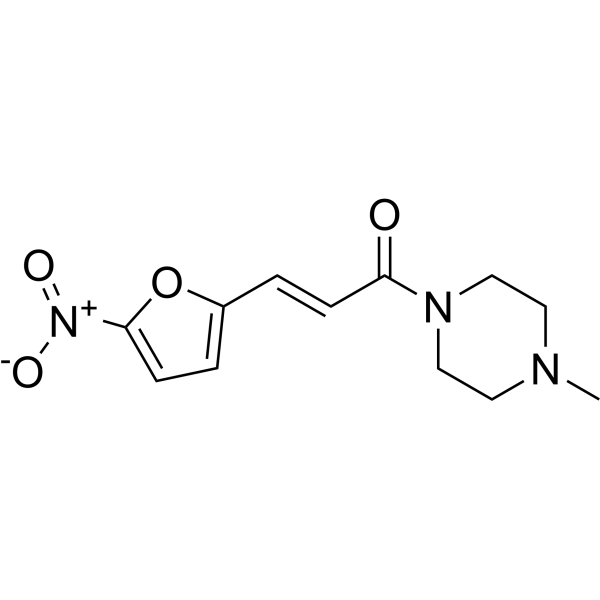
-
- HY-158105
-
|
|
PROTACs
BCL6
|
Cancer
|
|
ARV-393 is an orally active PROTAC that utilizes the ubiquitin-proteasome system to target the degradation of BCL6. ARV-393 consists of ligand conjugates targeting BCL6 and the E3 ligase cereblon, respectively. ARV-393 has DC50 and GI50 values of <1 nM in multiple cell lines of diffuse large B-cell lymphoma (DLBCL) and Burkitt lymphoma (BL). ARV-393 also demonstrated considerable tumor suppressor activity in tumor xenograft models. ARV-393 is being studied to inhibit non-Hodgkin lymphoma.
|
-
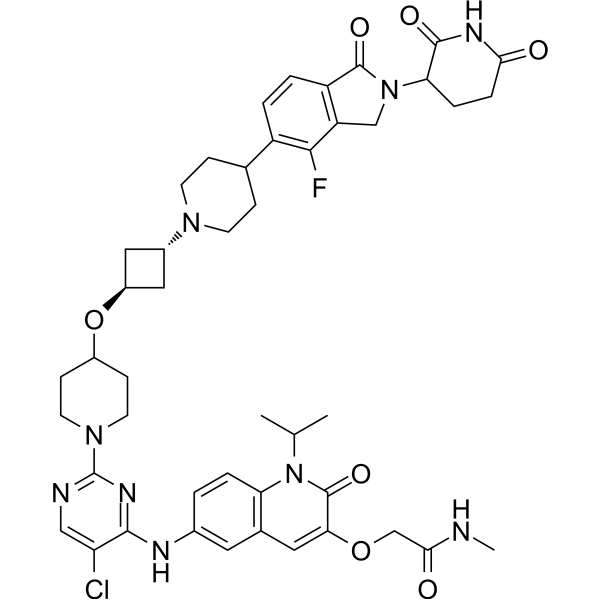
-
- HY-155552
-
|
|
Apoptosis
|
Cancer
|
|
GSPT1 degrader-1 (compound 9q) is a potent degrader of G1 to S phase transition 1 (GSPT1) via ubiquitin-proteasome system. GSPT1 degrader-1 also induces cell G0/G1 phase arrest and apoptosis .
|
-

-
- HY-152261
-
|
|
PROTACs
|
Cancer
|
|
MS6105 is an LDH protein hydrolysis-targeted chimera (PROTAC) that effectively degrades LDHA and LDHB in a time- and ubiquitin-proteasome system-dependent manner and has anticancer activity . MS6105 is a click chemistry reagent, it contains an Alkyne group and can undergo copper-catalyzed azide-alkyne cycloaddition (CuAAc) with molecules containing Azide groups.
|
-
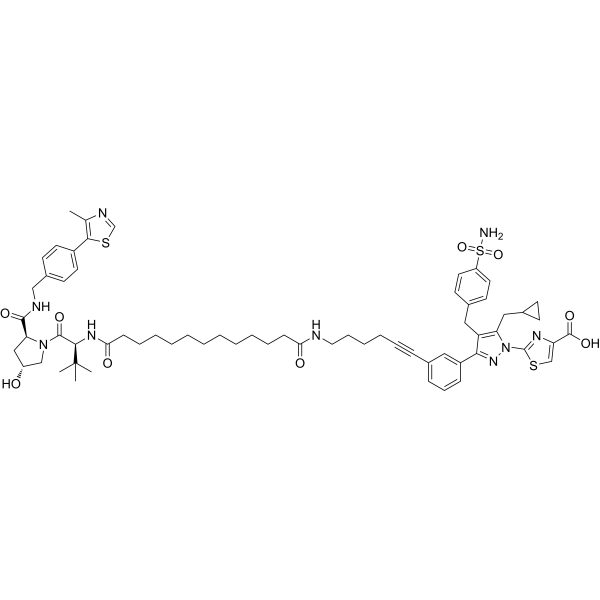
-
- HY-162250
-
|
|
PROTACs
Histone Methyltransferase
|
Cancer
|
|
MS8847 is a highly potent EZH2 PROTAC degrader that recruits the E3 ligase von Hippel-Lindau (VHL). MS8847 potently degrades EZH2 in a ubiquitin-proteasome system-dependent manner. MS8847 effectively inhibits the growth of acute myeloid leukemia (AML) and triple-negative breast cancer (TNBC) cells .
|
-

-
- HY-149228
-
|
|
Deubiquitinase
|
Cancer
|
|
USP28-IN-2 is a USP28 inhibitor (IC50=0.3 μM) with high selectivity over USP2, USP7, USP8, USP9x, UCHL3 and UCHL5. USP28-IN-2 shows cytotoxicity against cancer cells, down-regulates the cellular level of c-Myc through ubiquitin-proteasome system. USP28-IN-2 also decreases the ankyrase-1/2 level in vitro. USP28-IN-2 enhance the sensitivity of colorectal cancer cells to Regorafenib (HY-10331) .
|
-
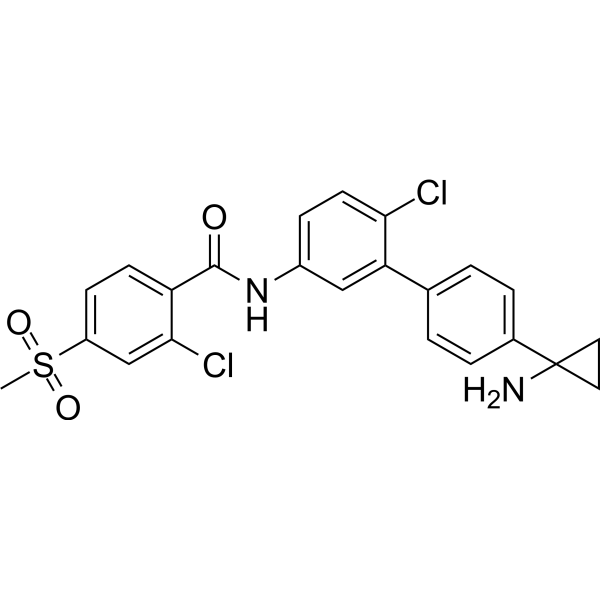
-
- HY-149229
-
|
|
Deubiquitinase
|
Cancer
|
|
USP28-IN-3 is a USP28 inhibitor (IC50=0.1 μM) with high selectivity over USP2, USP7, USP8, USP9x, UCHL3 and UCHL5. USP28-IN-3 shows cytotoxicity against cancer cells, down-regulates the cellular level of c-Myc through ubiquitin-proteasome system. USP28-IN-3 also decreases the ankyrase-1/2 level in vitro. USP28-IN-3 enhance the sensitivity of colorectal cancer cells to Regorafenib (HY-10331) .
|
-
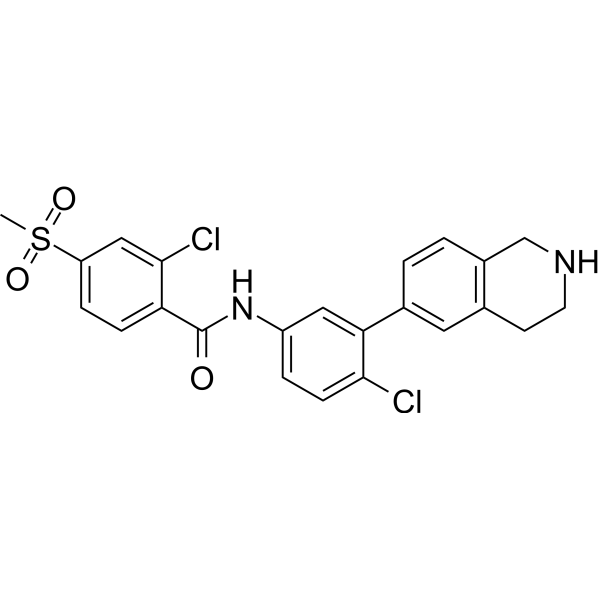
-
- HY-149230
-
|
|
Deubiquitinase
|
Cancer
|
|
USP28-IN-4 is a USP28 inhibitor (IC50=0.04 μM) with high selectivity over USP2, USP7, USP8, USP9x, UCHL3 and UCHL5. USP28-IN-4 shows cytotoxicity against cancer cells, down-regulates the cellular level of c-Myc through ubiquitin-proteasome system. USP28-IN-4 also decreases the ankyrase-1/2 level in vitro. USP28-IN-4 enhance the sensitivity of colorectal cancer cells to Regorafenib (HY-10331) .
|
-
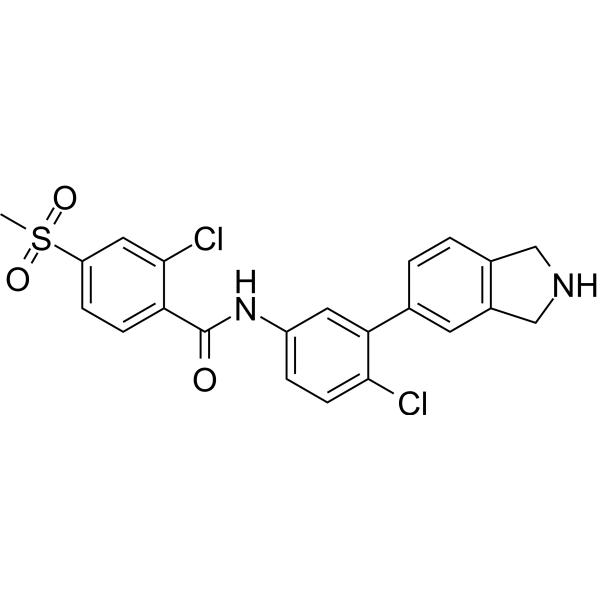
-
- HY-N7695
-
|
|
Apoptosis
Autophagy
|
Cancer
|
|
Physalin B, one of the major active steroidal constituents of Cape gooseberry, induces cell cycle arrest and triggers apoptosis in breast cancer cells through modulating p53-dependent apoptotic pathway. Physalin B inhibits the ubiquitin-proteasome pathway and induces incomplete autophagic response in human colon cancer cells in vitro .
|
-
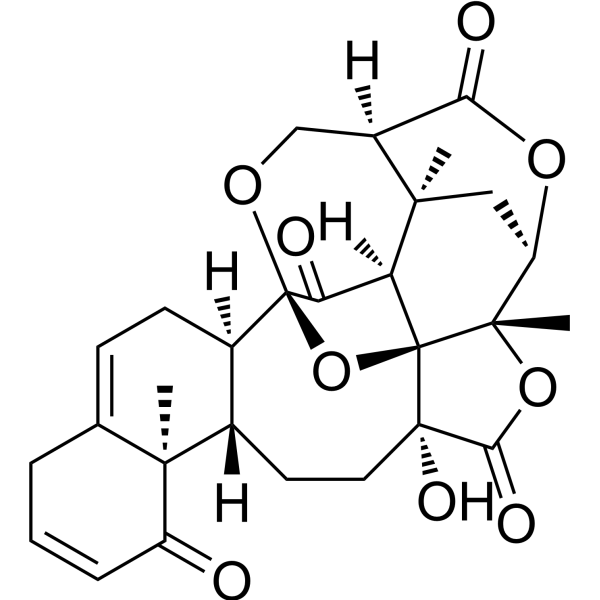
-
- HY-157788
-
|
|
PROTACs
Reactive Oxygen Species
Ferroptosis
Glutathione Peroxidase
|
Cancer
|
|
ZX703 (compound 5I) is a PROTAC that significantly degrades GPX4 in a dose- and time-dependent manner through the ubiquitin-proteasome and autophagy-lysosome pathways (DC50=0.315 µM). ZX703 induces ferroptosis by inducing Reactive Oxygen Species (ROS) accumulation in cells. ZX703 can be used for cancer research .
|
-
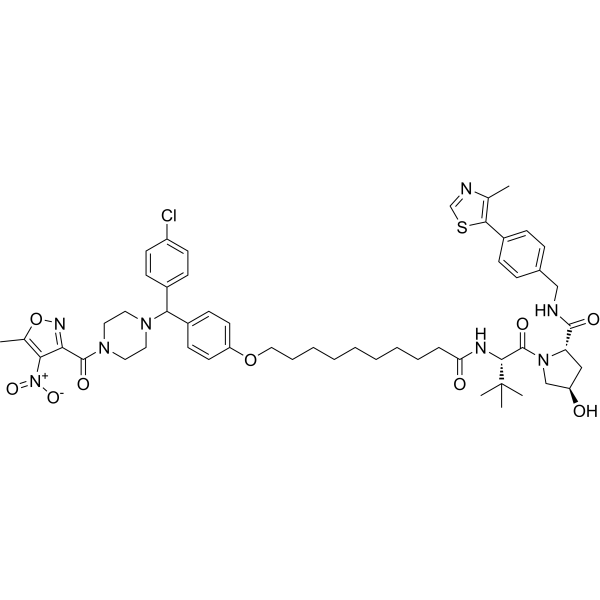
-
- HY-147942
-
|
|
PROTACs
EGFR
|
Cancer
|
|
MS9449 is a potent PROTAC EGFR degrader with Kds of 17 nM and 10 nM for EGFR WT and EGFR L858R, respectively. MS9449 effectively induces degradation of mutant EGFRs through both the ubiquitin/proteasome system (UPS) and autophagy/lysosome pathways. MS9449 potently inhibits the proliferation of NSCLC cells. MS9449 can be used for researching anticancer .
|
-
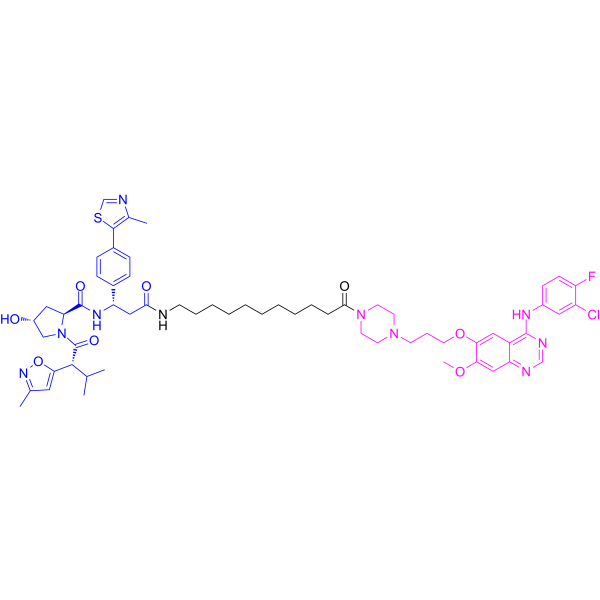
-
- HY-147941
-
|
|
PROTACs
EGFR
|
Cancer
|
|
MS9427 is a potent PROTAC EGFR degrader with Kds of 7.1 nM and 4.3 nM for EGFR WT and EGFR L858R, respectively. MS9427 selectively degrades the mutant but not the WT EGFR through both the ubiquitin/proteasome system (UPS) and autophagy/lysosome pathways. MS9427 potently inhibits the proliferation of NSCLC cells. MS9427 can be used for researching anticancer .
|
-

-
- HY-111875
-
|
|
SNIPERs
Epigenetic Reader Domain
|
Cancer
|
|
SNIPER(BRD)-1, consists of an IAP antagonist LCL-161 derivative and a BET inhibitor, (+)-JQ-1, connected by a linker. SNIPER(BRD)-1 induces the degradation of BRD4 via the ubiquitin-proteasome pathway. SNIPER(BRD)-1 also degrades cIAP1 , cIAP2 and XIAP with IC50s of 6.8 nM, 17 nM, and 49nM, respectively .
|
-
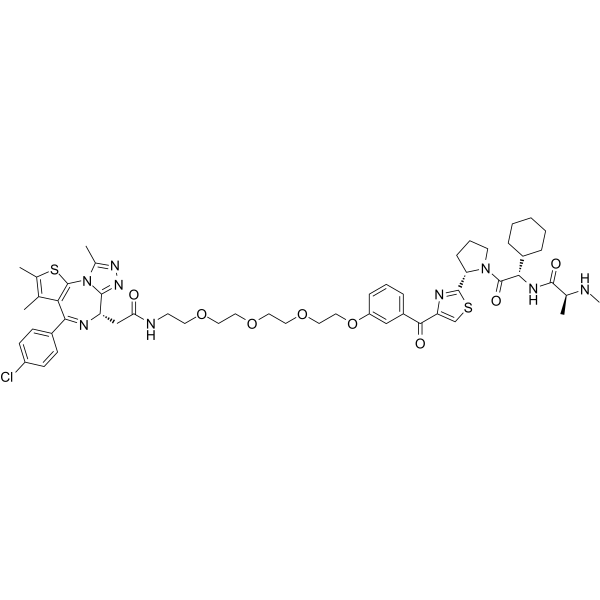
-
- HY-130715
-
|
|
PROTAC Linkers
|
Cancer
|
|
tert-Butyl 11-aminoundecanoate (compound 6b) is a PROTAC linker, which refers to the PEG composition. tert-Butyl 11-aminoundecanoate can be used in the synthesis of a series of PROTACs. PROTACs contain two different ligands connected by a linker; one is a ligand for an E3 ubiquitin ligase and the other is for the target protein. PROTACs exploit the intracellular ubiquitin-proteasome system to selectively degrade target proteins .
|
-

-
- HY-129773
-
|
|
PROTAC Linkers
|
Cancer
|
|
Phthalimide-PEG4-PDM-OTBS is a PROTAC linker, which refers to the PEGs composition. Phthalimide-PEG4-PDM-OTBS can be used in the synthesis of a series of PROTACs. PROTACs contain two different ligands connected by a linker; one is a ligand for an E3 ubiquitin ligase and the other is for the target protein. PROTACs exploit the intracellular ubiquitin-proteasome system to selectively degrade target proteins .
|
-
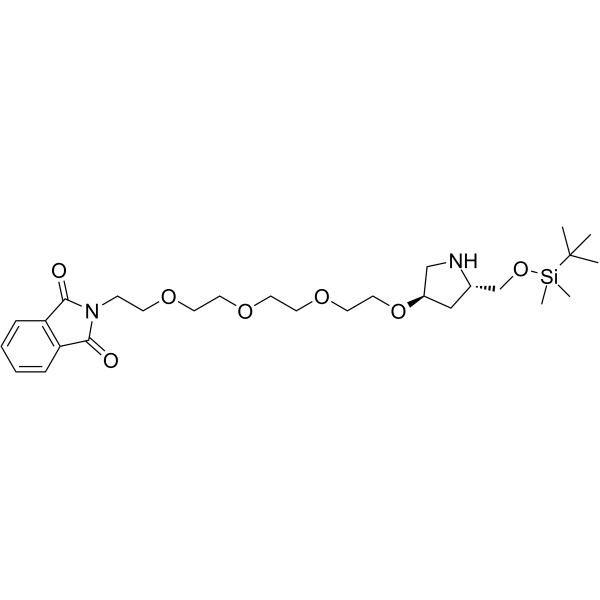
-
- HY-129774
-
|
|
PROTAC Linkers
|
Cancer
|
|
Phthalimide-PEG4-MPDM-OH is a PROTAC linker, which refers to the PEGs composition. Phthalimide-PEG4-MPDM-OH can be used in the synthesis of a series of PROTACs. PROTACs contain two different ligands connected by a linker; one is a ligand for an E3 ubiquitin ligase and the other is for the target protein. PROTACs exploit the intracellular ubiquitin-proteasome system to selectively degrade target proteins .
|
-
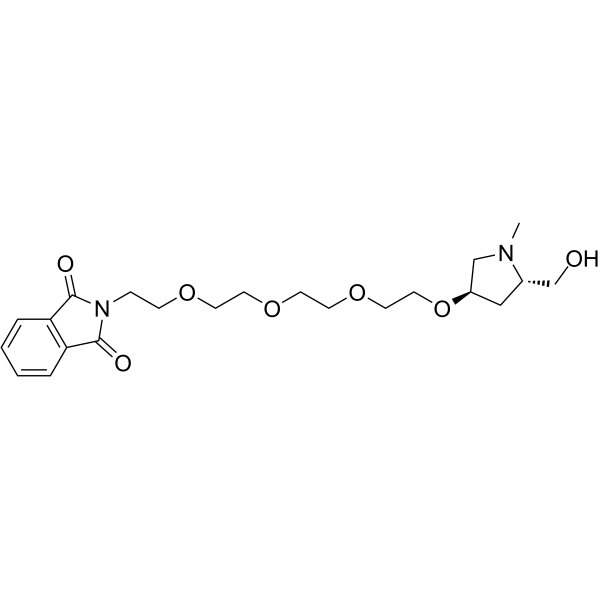
-
- HY-152134
-
|
|
HDAC
PROTACs
|
Cancer
|
|
HDAC6 degrader-3 is a potent and selective HDAC6 degrader via ternary complex formation and the ubiquitin-proteasome pathway with a DC50 value of 19.4 nM. HDAC6 degrader-3 has IC50s of 4.54 nM and 0.647 μM for HDAC6 and HDAC1, respectively. HDAC6 degrader-3 causes strong hyperacetylation of α-tubulin .
|
-
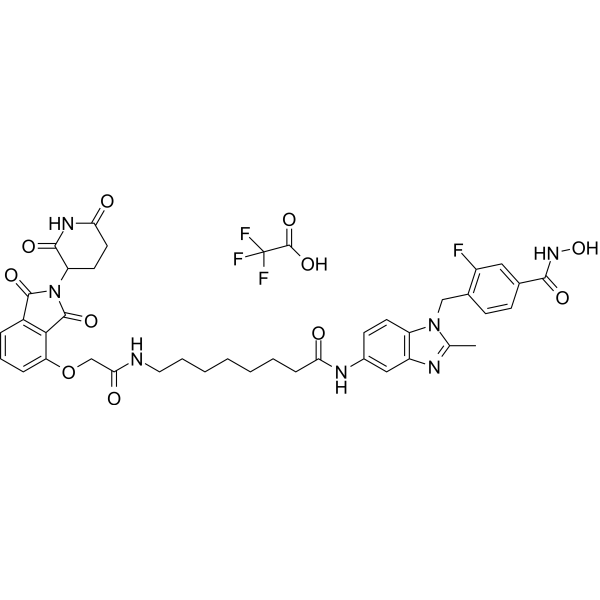
-
- HY-147941A
-
|
|
PROTACs
EGFR
|
Cancer
|
|
MS9427 TFA is a potent PROTAC EGFR degrader with Kds of 7.1 nM and 4.3 nM for EGFR WT and EGFR L858R, respectively. MS9427 TFA selectively degrades the mutant but not the WT EGFR through both the ubiquitin/proteasome system (UPS) and autophagy/lysosome pathways. MS9427 TFA potently inhibits the proliferation of NSCLC cells. MS9427 TFA can be used for researching anticancer .
|
-
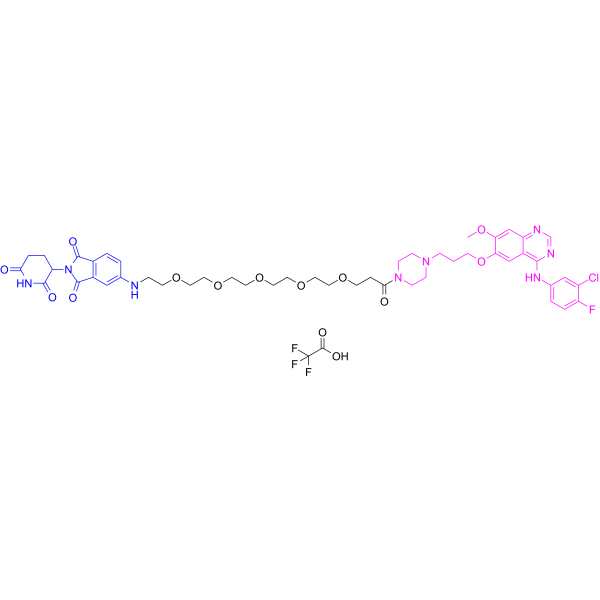
-
- HY-69220
-
|
|
PROTAC Linkers
|
Cancer
|
|
7-Octynoic acid (compound 42) is a PROTAC linker and can be used in the synthesis of a series of PROTACs. PROTACs contain two different ligands connected by a linker; one is a ligand for an E3 ubiquitin ligase and the other is for the target protein. PROTACs exploit the intracellular ubiquitin-proteasome system to selectively degrade target proteins . 7-Octynoic acid is a click chemistry reagent, it contains an Alkyne group and can undergo copper-catalyzed azide-alkyne cycloaddition (CuAAc) with molecules containing Azide groups.
|
-
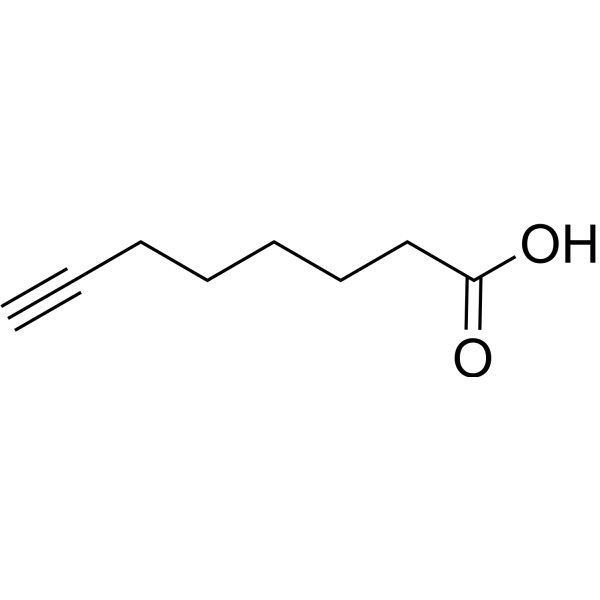
-
- HY-129772
-
|
|
PROTAC Linkers
|
Cancer
|
|
Phthalimide-PEG3-C2-OTs (Compound 5) is a PROTAC linker, which refers to the PEGs composition. Phthalimide-PEG3-C2-OTs can be used in the synthesis of a series of PROTACs. PROTACs contain two different ligands connected by a linker; one is a ligand for an E3 ubiquitin ligase and the other is for the target protein. PROTACs exploit the intracellular ubiquitin-proteasome system to selectively degrade target proteins .
|
-
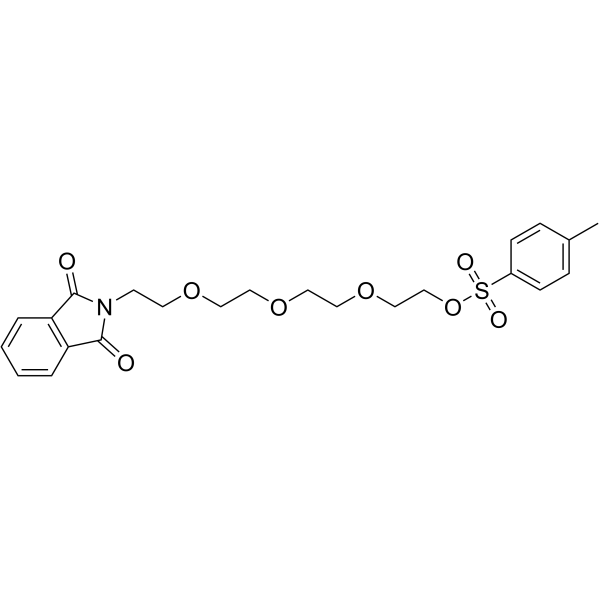
-
- HY-40178
-
|
|
PROTAC Linkers
|
Cancer
|
|
NH2-C4-NH-Boc (compound 15) is a PROTAC linker, which refers to the Alkyl/ether composition. NH2-C4-NH-Boc can be used in the synthesis of a series of PROTACs. PROTACs contain two different ligands connected by a linker; one is a ligand for an E3 ubiquitin ligase and the other is for the target protein. PROTACs exploit the intracellular ubiquitin-proteasome system to selectively degrade target proteins .
|
-
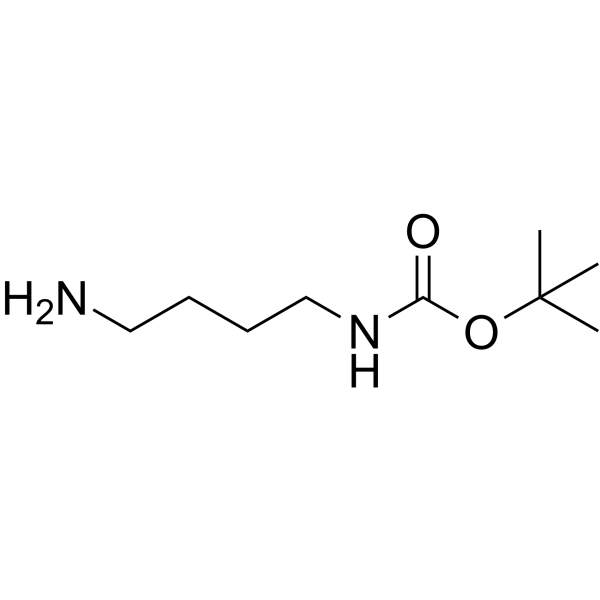
-
- HY-153896
-
|
|
c-Met/HGFR
|
Cancer
|
|
LMTK3-IN-1 (compound C28) is an ATP-competitive inhibitor of lemur tyrosine kinase 3 (LMTK3) (Kd=2.5 μM),that acts by degrading LMTK3 via the ubiquitin-proteasome pathway. LMTK3-IN-1 shows anticancer activity in a variety of cancer cell lines and in vivo BC mouse models. LMTK3-IN-1 induces apoptosis in BC cell lines at 10-20 μM .
|
-

-
- HY-144980
-
|
|
Ligands for E3 Ligase
|
Cancer
|
|
E3 ligase Ligand 21 (compound 2) is a cereblon binder for the degradation of Ikaros or Aiolos by the ubiquitin proteasome pathway .
|
-
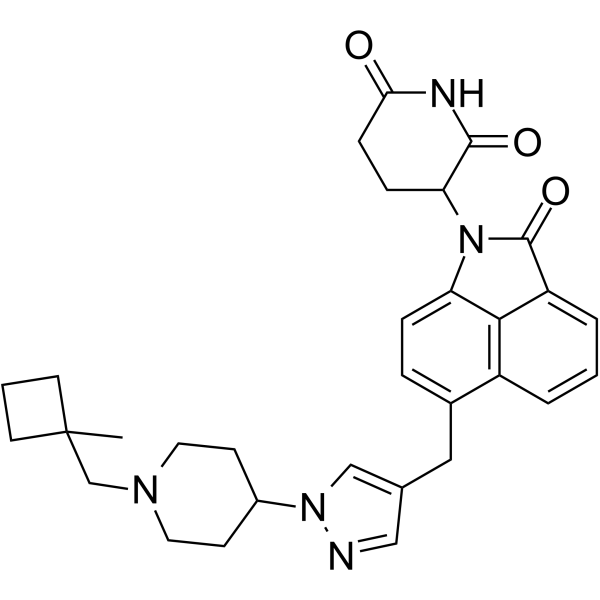
-
- HY-144983
-
|
|
Ligands for E3 Ligase
|
Cancer
|
|
E3 ligase Ligand 22 (compound 139) is a cereblon binder for the degradation of Ikaros or Aiolos by the ubiquitin proteasome pathway .
|
-
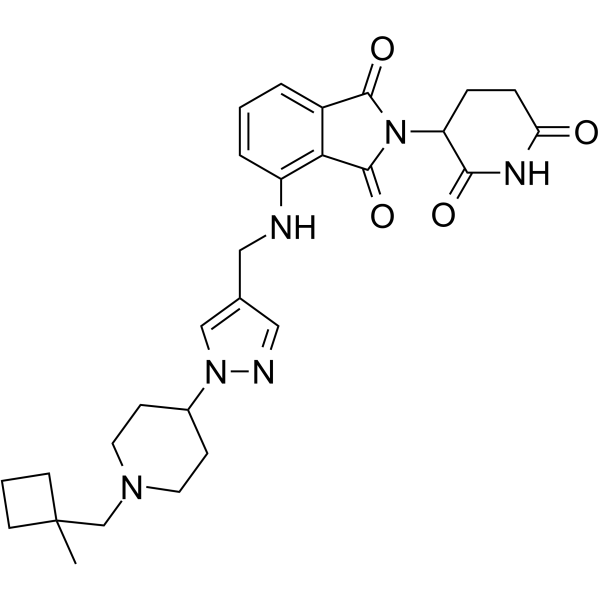
-
- HY-130618
-
|
|
PROTAC Linkers
|
Cancer
|
|
Boc-C1-PEG3-C4-OH is a PROTAC linker, which refers to the Alkyl/ether composition. Boc-C1-PEG3-C4-OH can be used in the synthesis of a series of PROTACs. PROTACs contain two different ligands connected by a linker; one is a ligand for an E3 ubiquitin ligase and the other is for the target protein. PROTACs exploit the intracellular ubiquitin-proteasome system to selectively degrade target proteins .
|
-

-
- HY-144985
-
|
|
Ligands for E3 Ligase
|
Cancer
|
|
E3 ligase Ligand 23 (compound 17-6) is a cereblon binder for the degradation of Ikaros or Aiolos by the ubiquitin proteasome pathway .
|
-
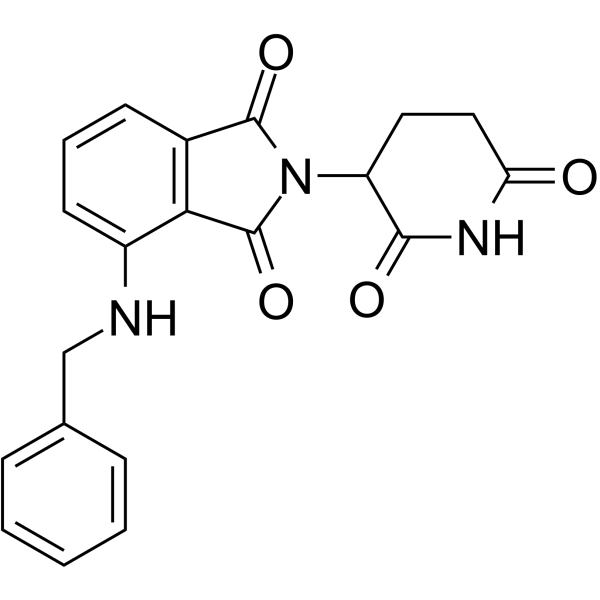
-
- HY-130619
-
|
|
PROTAC Linkers
|
Cancer
|
|
Boc-C1-PEG3-C4-OBn (PROTAC Linker 15) is a PROTAC linker, which refers to the PEG composition. Boc-C1-PEG3-C4-OBn can be used in the synthesis of a series of PROTACs, such as PROTAC SGK3 degrader-1 (HY-125878). PROTACs contain two different ligands connected by a linker; one is a ligand for an E3 ubiquitin ligase and the other is for the target protein. PROTACs exploit the intracellular ubiquitin-proteasome system to selectively degrade target proteins .
|
-
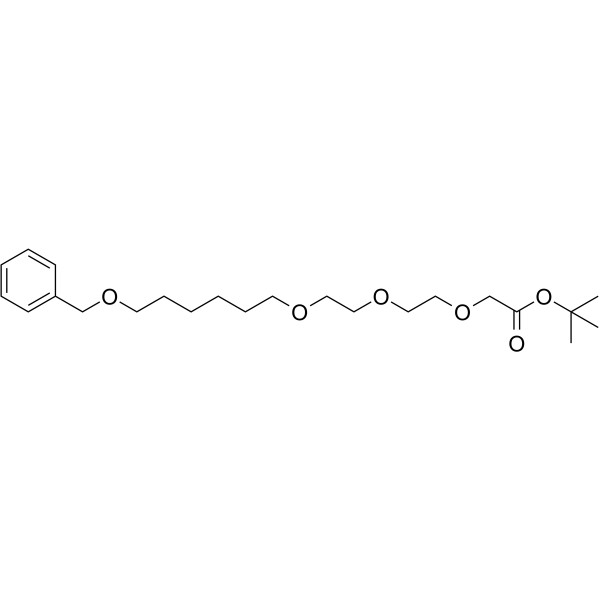
-
- HY-155008
-
|
|
Hexokinase
|
Cancer
|
|
PROTAC HK2 Degrader-1 is a PROTAC consisting of Lonidamine (HY-B0486) as a target protein Hexokinase 2 (HK2) inhibitor and Thalidomide (HY-14658) as a CRBN ligand-linked PROTAC. PROTAC HK2 Degrader-1 selectively inhibits the proliferation of breast cancer cells by forming a ternary complex through the ubiquitin-proteasome system to degrade Hexokinase 2 (HK2) protein leading to mitochondrial damage and cell death. PROTAC HK2 Degrader-1 effectively inhibits breast tumor growth and reduces the colonic side effects of cisplatin for breast cancer research .
|
-
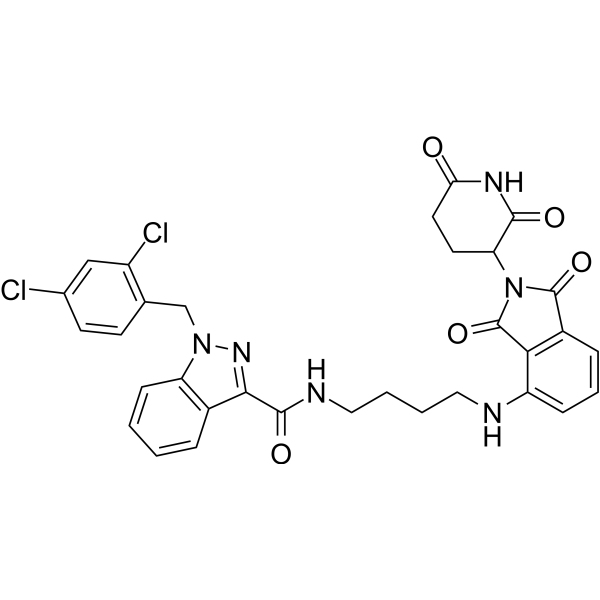
-
- HY-108374
-
|
|
PROTAC Linkers
|
Cancer
|
|
4-Azidobutylamine is a PROTAC linker, which refers to the alkyl chain composition. 4-Azidobutylamine can be used in the synthesis of a series of PROTACs. PROTACs contain two different ligands connected by a linker; one is a ligand for an E3 ubiquitin ligase and the other is for the target protein. PROTACs exploit the intracellular ubiquitin-proteasome system to selectively degrade target proteins . 4-Azidobutylamine is a click chemistry reagent, it contains an Azide group and can undergo copper-catalyzed azide-alkyne cycloaddition reaction (CuAAc) with molecules containing Alkyne groups. Strain-promoted alkyne-azide cycloaddition (SPAAC) can also occur with molecules containing DBCO or BCN groups.
|
-
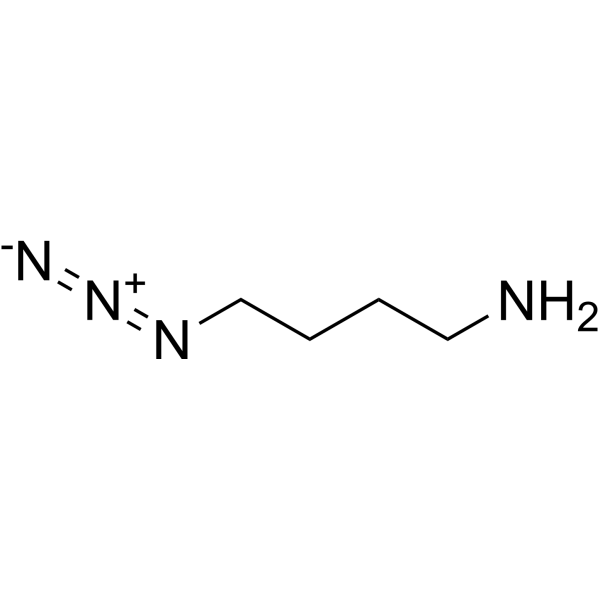
-
- HY-161180
-
|
|
NAMPT
|
Cancer
|
|
Antitumor Agent-136 (Compound 17) is a potent broad-spectrum antitumor agent and a NAMPT inhibitor with an IC50 of 9.5 nM. Antitumor Agent-136 can reduce the levels of intracellular and extracellular NAMPT protein through the ubiquitin proteasome pathway, thus achieving tumor inhibition .
|
-
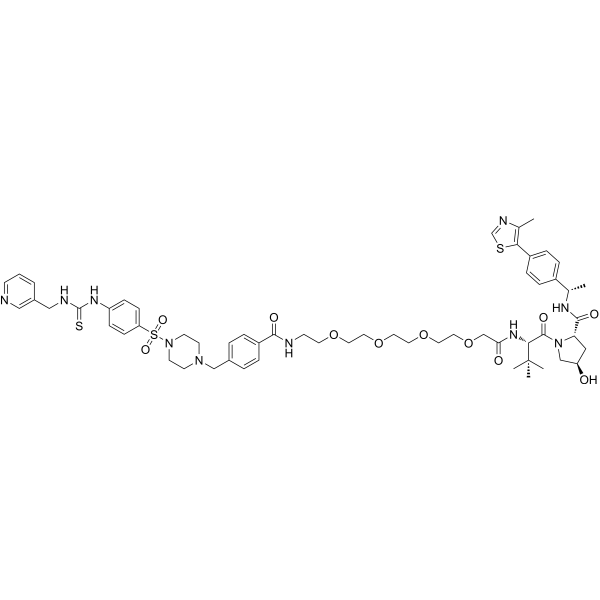
-
- HY-144841A
-
|
(Rac)-CFT7455
|
Others
|
Cancer
|
|
(Rac)-Cemsidomide ((Rac)-CFT7455) is a zinc finger transcription factors Ikaros (IKZF1) and Aiolos (IKZF3) degrader, acting via the ubiquitin proteasome pathway, with a GI50 of 0.05 nM for NCIH929.1 cells. (Rac)-Cemsidomide is the racemic isomer of Cemsidomide (HY-144841A) which is a IKZF1/IKZF3 degrader with anticancer activity .
|
-

-
- HY-136242
-
|
|
Androgen Receptor
|
Endocrinology
Cancer
|
|
UT-34 is a potent, selective and orally active second-generation pan-androgen receptor (AR) antagonist and degrader with IC50s of 211.7 nM, 262.4 nM and 215.7 nM for wild-type, F876L and W741L AR, respectively. UT-34 binds to ligand-binding domain (LBD) and function-1 (AF-1) domains and requires ubiquitin proteasome pathway to degrade the AR. UT-34 has anti-prostate cancer efficacy .
|
-
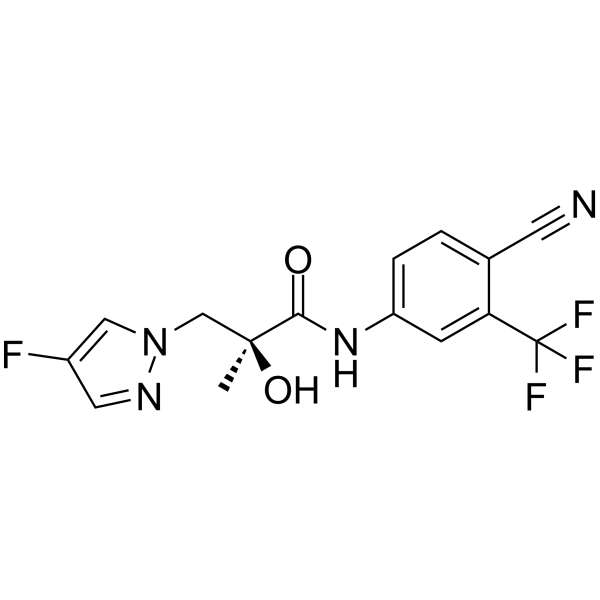
-
- HY-141431
-
|
|
E3 Ligase Ligand-Linker Conjugates
|
Inflammation/Immunology
Cancer
|
|
Cbl-b-IN-2 (Example 8) is an orally bioavailable compound, can inhibit the E3 enzyme Casitas B-lineage lymphoma proto-oncogene-b (Cbl-b) in the ubiquitin proteasome pathway. Cbl-b-IN-2 can be used to modulate the immune system and diseases amenable to immune system modulation. Cbl-b-IN-2 (Example 8) also may be administered to an individual with cancer, either alone or as part of a combination, with one or more of an immune checkpoint inhibitor, an anti-neoplastic agent, and radiation agent .
|
-
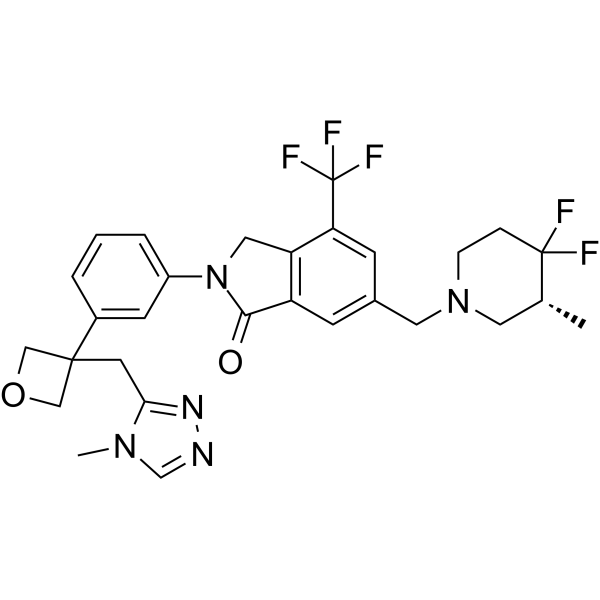
-
- HY-139996
-
|
|
PROTACs
Ligands for E3 Ligase
|
Cancer
|
|
Pomalidomide-C5-Dovitinib (compound 2) is a PROTAC containing Pomalidomide, Dovitinib and connected with CRBN. Pomalidomide-C5-Dovitinib shows enhanced antiproliferative effects against FLT3-ITD+ AML cells. Pomalidomide-C5-Dovitinib induces the degradation of the FLT3-ITD and KIT proteins in a ubiquitin-proteasome-dependent manner and completely blocks their downstream signaling pathway. Pomalidomide-C5-Dovitinib has the potential for the research of FLT3-ITD + acute myeloid leukemia .
|
-
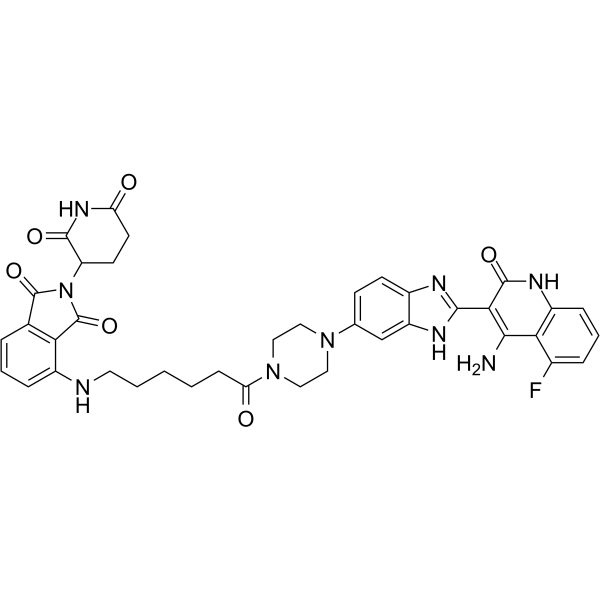
- HY-A0023AS2
-
-

- HY-140307A
-
|
|
PROTAC Linkers
|
Others
|
|
Sulfo DBCO-PEG4-Maleimide TEA is a PEG-based PROTAC linker that can be used in the synthesis of PROTACs . Sulfo DBCO-PEG4-Maleimide (TEA) is a click chemistry reagent, it contains a DBCO group that can undergo strain-promoted alkyne-azide cycloaddition (SPAAC) with molecules containing Azide groups.
|
-

- HY-157764
-
|
|
PROTACs
ATM/ATR
|
Cancer
|
|
PROTAC ATR degrader-1 (compound ZS-7) is a potent PROTAC degrader of ataxia telangiectasia and Rad3-related (ATR), with DC50 of 0.53 μM. PROTAC ATR degrader-1 plays an importnt role in cancer research .
|
-
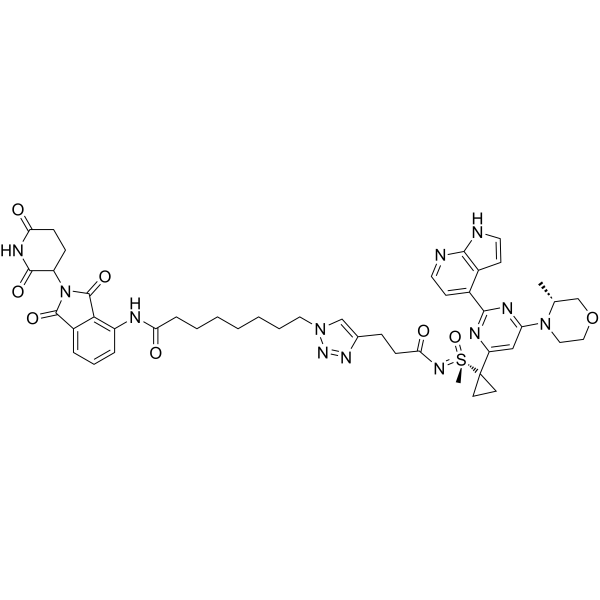
- HY-161173
-
|
|
PROTACs
Ras
|
Cancer
|
|
PROTAC SOS1 degrader-5 (compound 4) is a potent PROTAC SOS1 degrader, with the DC50 of 13 nM. PROTAC SOS1 degrader-5 strongly inhibits NCI-H358 cells proliferation with an IC50 of 5 nM .
|
-

- HY-140902A
-
|
|
PROTAC Linkers
|
Cancer
|
|
Biotin-PEG3-C3-NH2 is a PEG-based PROTAC linker, with NH2 functional group, that can be used in the synthesis of PROTACs .
|
-

- HY-145762
-
|
|
Apoptosis
Histone Methyltransferase
|
Cancer
|
|
YM281 is a potent EZH2 inhibitor. YM281 induces cell apoptosis and cell cycle arrest at the G0/G1 phase. YM281 shows antitumor effects in vivo. YM281 has the potential for the research of lymphoma .
|
-
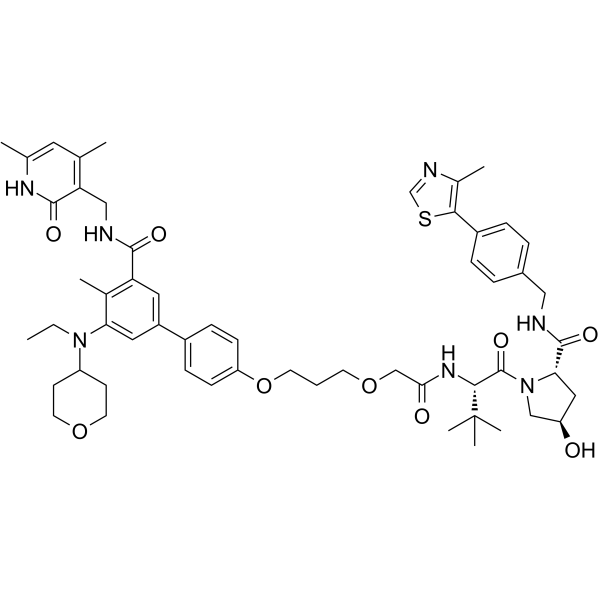
- HY-139999
-
|
|
Ligands for E3 Ligase
|
Cancer
|
|
LCL-PEG3-N3 is a decoy oligonucleotide ligand for E3 ligase which can be used for developing chimeric molecules LCL-ER(dec), degrading the estrogen receptor . LCL-PEG3-N3 is a click chemistry reagent, it contains an Azide group and can undergo copper-catalyzed azide-alkyne cycloaddition reaction (CuAAc) with molecules containing Alkyne groups. Strain-promoted alkyne-azide cycloaddition (SPAAC) can also occur with molecules containing DBCO or BCN groups.
|
-
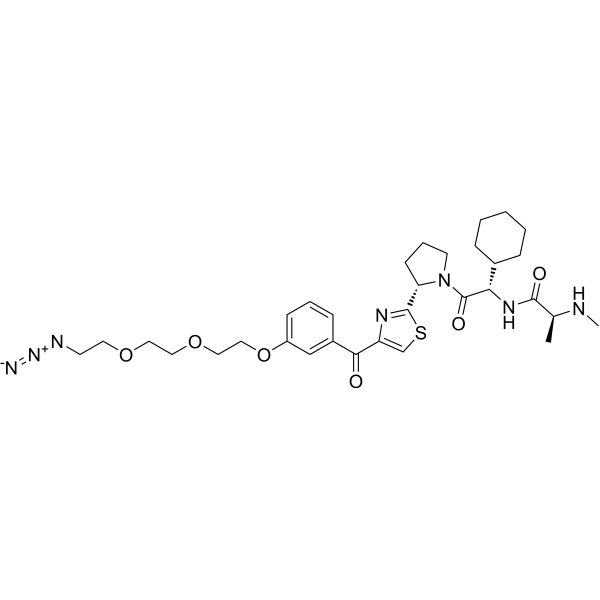
- HY-139999A
-
|
|
Ligands for E3 Ligase
|
Cancer
|
|
LCL-PEG3-N3 (hydrochloride) is a decoy oligonucleotide ligand for E3 ligase which can be used for developing chimeric molecules LCL-ER(dec), degrading the estrogen receptor . LCL-PEG3-N3 (hydrochloride) is a click chemistry reagent, it contains an Azide group and can undergo copper-catalyzed azide-alkyne cycloaddition reaction (CuAAc) with molecules containing Alkyne groups. Strain-promoted alkyne-azide cycloaddition (SPAAC) can also occur with molecules containing DBCO or BCN groups.
|
-
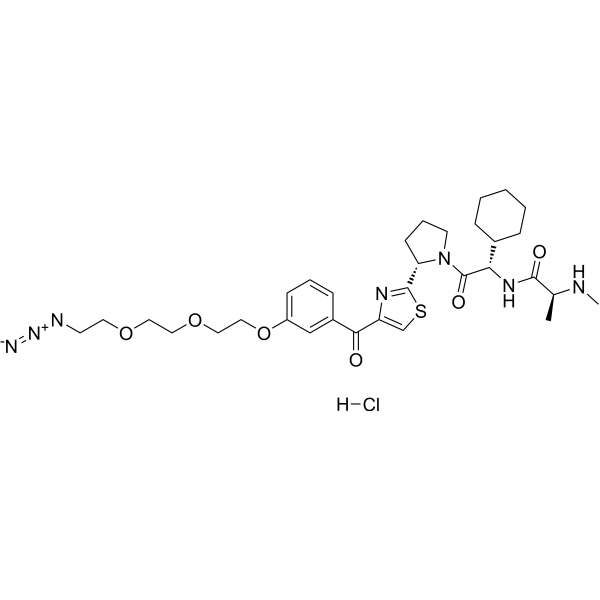
- HY-110167
-
|
|
PGE synthase
Ligands for Target Protein for PROTAC
|
Cancer
|
|
TFC-007, a selective hematopoietic prostaglandin D synthase (H-PGDS) inhibitor, show high inhibitory activity against H-PGDS enzyme (IC50 value of 83 nM). TFC-007 can be used for composing H-PGDS degradation inducer PROTAC(H-PGDS)-1 (TFC-007 binds to H-PGDS, and Pomalidomide binds to cereblon) .
|
-
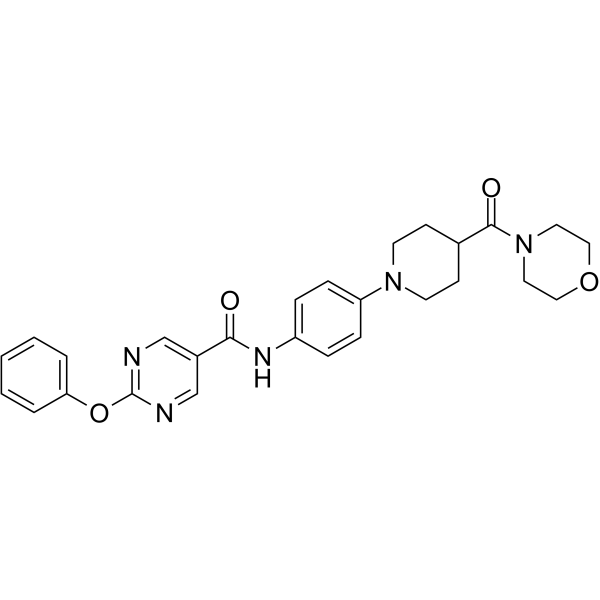
-
-
HY-L151
-
|
|
230 compounds
|
|
PROTACs (Proteolysis-targeting chimeras) is a class of molecules that utilize ubiquitin-proteasome system (UPS) to ubiquitinate and degrade target proteins. The PROTACs molecule consists of two ligands joined by a linker. The one-to-one interaction between PROTACs and target proteins determines the high efficiency of PROTACs, making it a potential molecule for targeted protein degradation (TPD) therapy.
MCE supplies a unique collection of 230 PROTACs that effectively degrade target proteins with more powerful screening capability. MCE PROTAC Library is a useful tool for signal pathway research, protein degradation therapy research, drug discovery and drug repurposing, etc.
|
| Cat. No. |
Product Name |
Target |
Research Area |
-
- HY-P1259A
-
|
|
Proteasome
Bacterial
|
Inflammation/Immunology
|
|
PR-39 TFA, a natural proline- and arginine-rich antibacterial peptide, is a noncompetitive, reversible and allosteric proteasome inhibitor. PR-39 TFAreversibly binds to the α7 subunit of the proteasome and blocks degradation of NF-κB inhibitor IκBα by the ubiquitin-proteasome pathway. PR-39 TFA stimulates angiogenesis, inhibits inflammatory responses and significant reduces myocardial infarct size in mice .
|
-
- HY-P1259
-
|
|
Proteasome
Bacterial
|
Inflammation/Immunology
|
|
PR-39, a natural proline- and arginine-rich antibacterial peptide, is a noncompetitive, reversible and allosteric proteasome inhibitor. PR-39 reversibly binds to the α7 subunit of the proteasome and blocks degradation of NF-κB inhibitor IκBα by the ubiquitin-proteasome pathway. PR-39 stimulates angiogenesis, inhibits inflammatory responses and significant reduces myocardial infarct size in mice .
|
| Cat. No. |
Product Name |
Category |
Target |
Chemical Structure |
| Cat. No. |
Product Name |
Chemical Structure |
-
- HY-A0023AS2
-
|
|
|
Sulfo DBCO-PEG4-Maleimide TEA is a PEG-based PROTAC linker that can be used in the synthesis of PROTACs .
|
-

| Cat. No. |
Product Name |
|
Classification |
-
- HY-69220
-
|
|
|
Alkynes
PROTAC Synthesis
|
|
7-Octynoic acid (compound 42) is a PROTAC linker and can be used in the synthesis of a series of PROTACs. PROTACs contain two different ligands connected by a linker; one is a ligand for an E3 ubiquitin ligase and the other is for the target protein. PROTACs exploit the intracellular ubiquitin-proteasome system to selectively degrade target proteins . 7-Octynoic acid is a click chemistry reagent, it contains an Alkyne group and can undergo copper-catalyzed azide-alkyne cycloaddition (CuAAc) with molecules containing Azide groups.
|
-
- HY-108374
-
|
|
|
Azide
PROTAC Synthesis
|
|
4-Azidobutylamine is a PROTAC linker, which refers to the alkyl chain composition. 4-Azidobutylamine can be used in the synthesis of a series of PROTACs. PROTACs contain two different ligands connected by a linker; one is a ligand for an E3 ubiquitin ligase and the other is for the target protein. PROTACs exploit the intracellular ubiquitin-proteasome system to selectively degrade target proteins . 4-Azidobutylamine is a click chemistry reagent, it contains an Azide group and can undergo copper-catalyzed azide-alkyne cycloaddition reaction (CuAAc) with molecules containing Alkyne groups. Strain-promoted alkyne-azide cycloaddition (SPAAC) can also occur with molecules containing DBCO or BCN groups.
|
-
- HY-140307A
-
|
|
|
DBCO
|
|
Sulfo DBCO-PEG4-Maleimide TEA is a PEG-based PROTAC linker that can be used in the synthesis of PROTACs . Sulfo DBCO-PEG4-Maleimide (TEA) is a click chemistry reagent, it contains a DBCO group that can undergo strain-promoted alkyne-azide cycloaddition (SPAAC) with molecules containing Azide groups.
|
-
- HY-139999
-
|
|
|
Azide
|
|
LCL-PEG3-N3 is a decoy oligonucleotide ligand for E3 ligase which can be used for developing chimeric molecules LCL-ER(dec), degrading the estrogen receptor . LCL-PEG3-N3 is a click chemistry reagent, it contains an Azide group and can undergo copper-catalyzed azide-alkyne cycloaddition reaction (CuAAc) with molecules containing Alkyne groups. Strain-promoted alkyne-azide cycloaddition (SPAAC) can also occur with molecules containing DBCO or BCN groups.
|
-
- HY-139999A
-
|
|
|
Azide
|
|
LCL-PEG3-N3 (hydrochloride) is a decoy oligonucleotide ligand for E3 ligase which can be used for developing chimeric molecules LCL-ER(dec), degrading the estrogen receptor . LCL-PEG3-N3 (hydrochloride) is a click chemistry reagent, it contains an Azide group and can undergo copper-catalyzed azide-alkyne cycloaddition reaction (CuAAc) with molecules containing Alkyne groups. Strain-promoted alkyne-azide cycloaddition (SPAAC) can also occur with molecules containing DBCO or BCN groups.
|
Your information is safe with us. * Required Fields.
Inquiry Information
- Product Name:
- Cat. No.:
- Quantity:
- MCE Japan Authorized Agent:



































































